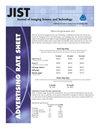Limitations of CNNs for Approximating the Ideal Observer Despite Quantity of Training Data or Depth of Network.
IF 0.5
4区 计算机科学
Q4 IMAGING SCIENCE & PHOTOGRAPHIC TECHNOLOGY
Journal of Imaging Science and Technology
Pub Date : 2020-11-01
DOI:10.2352/j.imagingsci.technol.2020.64.6.060408
引用次数: 0
Abstract
The performance of a convolutional neural network (CNN) on an image texture detection task as a function of linear image processing and the number of training images is investigated. Performance is quantified by the area under (AUC) the receiver operating characteristic (ROC) curve. The Ideal Observer (IO) maximizes AUC but depends on high-dimensional image likelihoods. In many cases, the CNN performance can approximate the IO performance. This work demonstrates counterexamples where a full-rank linear transform degrades the CNN performance below the IO in the limit of large quantities of training data and network layers. A subsequent linear transform changes the images' correlation structure, improves the AUC, and again demonstrates the CNN dependence on linear processing. Compression strictly decreases or maintains the IO detection performance while compression can increase the CNN performance especially for small quantities of training data. Results indicate an optimal compression ratio for the CNN based on task difficulty, compression method, and number of training images.无论训练数据量或网络深度如何,cnn逼近理想观测器的局限性。
研究了卷积神经网络(CNN)在图像纹理检测任务中的性能作为线性图像处理和训练图像数量的函数。性能通过受试者工作特征曲线下面积(AUC)来量化。理想观测器(IO)最大化AUC,但依赖于高维图像的可能性。在许多情况下,CNN的性能可以接近IO的性能。这项工作展示了反例,其中在大量训练数据和网络层的限制下,全秩线性变换会降低CNN的性能。随后的线性变换改变了图像的相关结构,提高了AUC,再次证明了CNN对线性处理的依赖性。压缩严格地降低或维持了IO检测性能,而压缩可以提高CNN的性能,特别是对于少量的训练数据。结果表明,基于任务难度、压缩方法和训练图像数量的CNN的最佳压缩比。
本文章由计算机程序翻译,如有差异,请以英文原文为准。
求助全文
约1分钟内获得全文
求助全文
来源期刊

Journal of Imaging Science and Technology
工程技术-成像科学与照相技术
CiteScore
2.00
自引率
10.00%
发文量
45
审稿时长
>12 weeks
期刊介绍:
Typical issues include research papers and/or comprehensive reviews from a variety of topical areas. In the spirit of fostering constructive scientific dialog, the Journal accepts Letters to the Editor commenting on previously published articles. Periodically the Journal features a Special Section containing a group of related— usually invited—papers introduced by a Guest Editor. Imaging research topics that have coverage in JIST include:
Digital fabrication and biofabrication;
Digital printing technologies;
3D imaging: capture, display, and print;
Augmented and virtual reality systems;
Mobile imaging;
Computational and digital photography;
Machine vision and learning;
Data visualization and analysis;
Image and video quality evaluation;
Color image science;
Image archiving, permanence, and security;
Imaging applications including astronomy, medicine, sports, and autonomous vehicles.
 求助内容:
求助内容: 应助结果提醒方式:
应助结果提醒方式:


